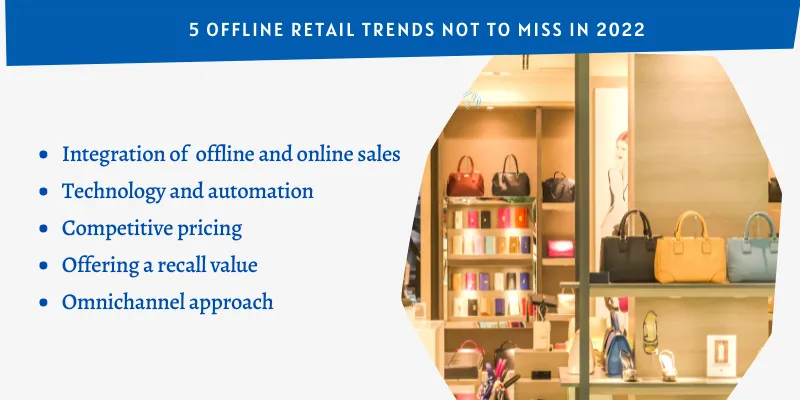[Year in Review 2021] Here are the trends that will reshape offline retail in 2022 and beyond
While the pandemic was tough for many entrepreneurs, for some, it was a time to reflect and reshape business. Here are the trends that retail brands need to watch out for in 2022 and beyond.
Over the course of the last 21 months, many of us found solace in creative pursuits to brighten up our lives during this devastating pandemic. Nandini, a 24-year-old MBA student, too watched her friends and family members picking up different hobbies. Some grew plants while others explored their passion for cooking. But as someone who really enjoyed catching up with her friends and going on shopping, the lockdown appeared to be a nightmare.
“Going out was scary. And as much as I wanted to maintain social distance, it was very hard for a shopaholic like me to resist taking a walk in the market. I love hanging out. It’s not like I didn’t shop online, the whole world was doing that. But experiencing the purchase has its own excitement and I missed it,” she says.
Last year, offline stores remained shut during the lockdown, except for the ones dealing in essential items. This resulted in ecommerce growing at an all-time high pace in India with order volume increasing by 36 percent in the last quarter of 2020. From personal care, fashion, and grocery, consumers took to buying everything online. Soon, Nandini realised that she was left spoilt for choice, downloading multiple apps to shop from the best brands — but still she missed the personal touch that offline shopping gave her.
However, as the market opened up in 2021, it didn’t take long for customers to resort back to the offline mode of shopping, flocking to stores as soon as they could.
The pandemic also saw the rise of many D2C (direct-to-consumer) brands in India, witnessing phenomenal growth by having ‘online-only’ sale strategy. But, entrepreneurs believe that experience shopping will never go out of fashion, and these same D2C brands are now gearing up to foray into physical retail. Even traditional brands are aiming to expand their offline presence.
The year 2022 is expected to shape up the physical retail market to give customers a 360-degree experience. To understand the future of offline retail, SMBStory spoke to entrepreneurs and industry experts. Here are five trends that will shape offline retail in 2022 and beyond.
Integrating offline and online modes of sale
To serve customers like Nandini who prefer traditional brick and mortar shops available to fulfil their purchase interests, D2C brands are now foraying into physical retail channels.
Founder of Pinklay, a homegrown lifestyle brand, Daisy Tanwani says that shoppers love the comfort of online shopping but they also love the experience of shopping equally. This stands true, especially for slow fashion and lifestyle.
“In the coming time, brands will need to integrate both these experiences through various touchpoints to give customers choice and comfort,” she tells SMBStory.

Daisy Tanwani, Co-founder, Pinklay with an artisan
has grown multifold amid the pandemic after its inception in 2015 but Daisy wants more people across age groups to visit her store where she’d tell stories about her products and the incredible artisans whom the brand has been empowering since its inception. To this extent, she is speeding up the company’s offline expansion process.
“We already have one store in Bandra, Mumbai, and a second one is coming up in Indiranagar, Bengaluru,” Daisy says.
Standing out through tech
Tech is playing an important role in the growth of the business and is also disrupting offline retail by making shopping seamless for the customers. Kumar Rajagopalan, CEO, Retailers Association of India (RAI), believes that retailers need to build ‘endless aisles’ to be on top of their sales technique.
Endless aisle is a term used to describe a marketing and sales technique by which retailers provide customers present in the store with an opportunity to order products that are either not normally sold in the store or that are currently out of stock.
Daisy also resonates with Rajagopalan saying that stores have finite space, definitely less than warehousing. Stores, more than often, give customers a good low down on the kind of merchandise and then, the universe of choice can be further explored on our phone and tablet screens with the able guidance of retail staff. It's the best of both worlds.

Image credits: Team SMB
Maintaining competitive pricing
Online stores already have sales and discounts that go on multiple times a year to tempt customers and also make sure that their inventory moves fast, says Rohan Shah, Founder of Truerevo. However, the sheer experience of going out for shopping and of trying and buying, which was an obvious thing in the past, has now been given a lot more importance by the customer.
For physical retail, maintaining similar price levels across channels will help sales boom.
“Customers for apparel always prefer an offline sale as long as the store is accessible easily. We saw a huge spike in our offline stores as soon as the fear of the second COVID-19 wave was over and restrictions were lifted,” Rohan adds.
Giving a recall value
Rajagopalan shares that earlier, when people used to shop in a physical retail store, the shopkeeper used to recognise them. The familiarity made customers return to the same store. This is happening now also. The ecommerce marketplace and brand websites suggest products based on your last purchase.
“Building a recall value is very important. It is still relevant. The offline retailer must give a customer a reason to come back,” he adds.
Rajagopalan suggests that by introducing comfort shopping features like immediate home deliveries or helping customers select products based on their likes and dislikes can help offline retail tempt more customers increasing the recall value too.
Omnichannel is the future
The last but one of the biggest trends SMBStory wants to highlight is that retail is here to stay and that the boundaries between brick-and-mortar stores and online stores have already blurred, further emphasizing on the importance of omnichannel retail.
Bala Sarda, Founder of VAHDAM Teas, a made in India global tea brand, explains that many D2C brands who were not able to fit themselves into the offline retail will now get more acceptance. “Physical retail might diminish but not go away completely,” Bala says.
“Ultimately, a lot of products need engagement, touch, and feel. Better selection of brands, exclusive products and assortments can help boost and get retailers to attract customers to physical stores combined with great offers and maybe some discounts,” he adds.
VAHDAM Teas plans to enter all the gourmet chains, A and A plus stores, PAN India. As a second step, Bala says, adding that the company wants to get into general trade across the country in the near future.
Edited by Saheli Sen Gupta


![[Year in Review 2021] Here are the trends that will reshape offline retail in 2022 and beyond](https://images.yourstory.com/cs/21/0a385fc03e6011e999df3d1594bbde2c/SMB-32-1640108346622.png?mode=crop&crop=faces&ar=16%3A9&format=auto&w=1920&q=75)
![[Year in Review 2021] 5 trends that dominated the MSME sector](https://images.yourstory.com/cs/21/e1da3a20368f11ea8ceed32dbcb77ccc/MSME-sector12-1639978639558.png?fm=png&auto=format&h=100&w=100&crop=entropy&fit=crop)




